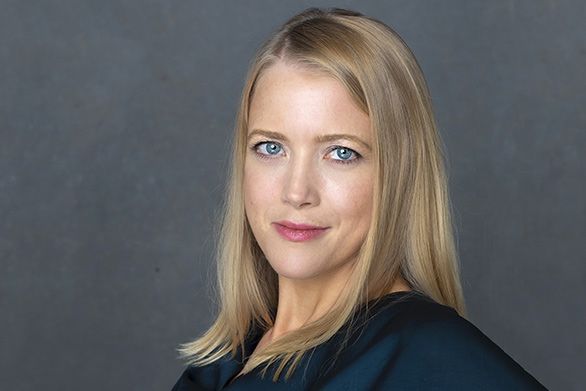Johnnie Alum Chronicles Lunar Exploration at the Smithsonian
March 5, 2021 | By George M. Spencer

When Teasel Muir-Harmony (A04) was a child, she loved learning ancient myths about the stars. She didn’t want to be an astronomer; she wanted to learn about the history of astronomy. Today, she plays a key role shaping how the world understands space exploration as curator of the Apollo Collection at the Smithsonian National Air & Space Museum.
The several thousand items in the Apollo Collection range from samples of space food and flight plans to personal radiation dosimeters and toothbrushes. Her favorite? “It’s hard to beat the Columbia command module, with its 500 switches and dials. It’s a remarkable piece of engineering ingenuity,” she says, referring to the spacecraft that Apollo 11 astronauts lived and worked in.
Muir-Harmony marvels at the “astro-graffiti” on its walls, jottings that include a calendar and technical scribbles. Her favorite is by Mike Collins, the Command Module Pilot (CMP). “He wrote almost an ode,” she says. Collins’ neat cursive script reads “Spacecraft 107 - alias Apollo 11 alias ‘Columbia.’ The Best Ship to Come Down the Line. God Bless Her.”
A scholar, author, and educator, Muir-Harmony regularly analyzes such artifacts. She also writes research papers, teaches the course “Space Flight and Globalization” at Georgetown University, has lectured for the State Department in Germany, Israel, and Slovenia, and helps design exhibits—including forthcoming ones on climate change and globalization. The newest exhibit, “Destination Moon,” premieres next year. “We are trying to tell a much more historically rich story about how lunar exploration connects to politics, culture, and society,” she says.
That interest in telling a broader story also led Muir-Harmony to create the six-part Smithsonian TV series Apollo’s Moon Shot and a companion augmented-reality app. Her first book Apollo to the Moon: A History in 50 Objects shares two other favorite artifacts—a sliver of the wooden propeller and fabric from the left wing of the plane the Wright Brothers flew on their first powered flight. Neil Armstrong took both to the Moon.
Muir-Harmony’s work is rooted in both childhood fascination and her education. At St. John’s, in addition to reading works by Ptolemy, Copernicus, and Kepler, she worked in the planetarium and observatory before earning her masters at Notre Dame and PhD at MIT in the history of science and technology. Her dissertation became the basis of her new book Operation Moonglow: A Political History of Project Apollo. (The title refers to President Nixon’s eight-nation post-Apollo 11 tour, which he used to seek foreign leaders’ help pushing the North Vietnamese into peace talks.)

In Operation Moonglow, Muir-Harmony details how the space race became the prime psychological battlefield of the Cold War‚ the literal high ground in the duel between the U.S. and the Soviet Union. Even before Sputnik launched, its chief engineer obsessed over the shiny sphere’s appearance. “This ball will be exhibited in museums!” he mused.
Humiliated that the world saw Russia as the world’s technological leader, the U.S. fought back. It created the largest ever sky’s-the-limit international publicity campaign of live space telecasts, movies, exhibits, brochures, and press conferences.
The PR barrage stressed “democratic values,” Muir-Harmony explains, especially America’s self-professed openness and its pursuit of space goals “for all mankind.” As a result, colossal foreign crowds greeted actual Mercury and Gemini capsules, whereas the Soviets kept theirs under wraps.
The naming of space capsules reflected the American “brand.” For example, Alan Shepard, the first American in space, rode aboard Freedom 7. “John Glenn chose the name Friendship 7 with help from his children. They wanted to express how the U.S. felt about the world. There was a lot of hope that this type of publicity would advance U.S.-foreign relations interests,” says Muir-Harmony.
Her book describes global tours by handsome astronauts with their picture-perfect wives, designed to distract the world from America’s civil rights and Vietnam woes. The campaign succeeded. “From Cape Kennedy not even a white mouse can be launched without the nation and the world learning about it a few minutes later,” gushed an Austrian newspaper in 1965.
Even after writing a book that focuses largely on the Earth-bound ramifications of lunar exploration, Muir-Harmony retains her sense of awe. A recent visit to Antarctica gave her a taste of what the vast desolation of space might be like. “What a stunning and alien place, with more shades of blue, white, and gray than I knew existed. It reminded me of Mike Collins’ description of the Earth from the Moon: ‘lurking right behind the beauty was a sense that it was fragile.’”
When asked if she would like to go to space as an astronaut or tourist, she admits she has a down-to-earth attitude. She’d like to see the Earth from orbit—“if it didn’t involve getting on a rocket,” she says. “It’s just like when I was a kid. I didn’t want to be an astronomer. I wanted to study the history of space. I really love being on Earth.”

